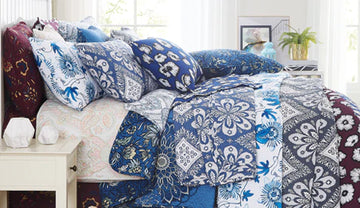Laundering Microfiber Sheets Properly
Microfiber sheets are very popular fabric for many reasons. They come in a multitude of colors and sizes, they’re easy to care for, and extremely affordable.
However, laundering microfiber sheets properly is very important. Otherwise you can damage the fibers and ruin the look. Let’s take a look at what microfiber is and how you can care for your microfiber sheets properly.
What is Microfiber?
Microfiber is a man-made fiber that is very thin and durable. A single microfiber is no thicker than a human hair, but far more resilient. It’s been around since the 1950’s, but it’s gained popularity in the past decade because it is so easy to care for and suits busy households that don’t have time to fuss with their bed linens.
Microfiber Sheet Quality
Just as with any other fabric, the quality of microfiber can vary. All sheet manufacturers grade microfiber by weight (grams per square meter, or GSM), not thread count.
A higher GSM indicates denser, more durable fabric. Sheets typically range between 90 and 110 GSM. A good quality set like these Vilano Deep Pocket Sheets offers 110 GSM and a lustrous, silky finish.
Microfibers are very thin and woven to feel silky, but they’re also very strong. They’re great for people with allergies since the weave is so tight they can trap dust mites and keep them away from your body.
Nonetheless, you need to treat your microfiber sheets with care otherwise they won’t last as long as they should.
Washing Microfiber Sheets
A good set of microfiber bed sheets should last far longer than cotton, bamboo, or silk making them extremely economical. Plus, you do not need to iron them for a very crisp, clean finish.
Always check the label for washing instructions. Typically, you’ll find the manufacturer recommends either a cold or warm water wash. The reason for this is high temperatures can melt the fibers and leave your sheets permanently wrinkled and uncomfortable.
Do not use fabric softener on microfiber sheets. Some people claim microfiber does not breathe, but of course this isn’t true - it’s a woven fabric. More likely, fabric softener clogged the spaces between the weave.
Do not wash microfiber with cotton, as it will pick up lint during the washing process. Wash microfiber sheets alone, or with other synthetics that do not produce lint.
Drying Microfiber Sheets
By far, drying microfiber sheets improperly is the most common way they’re ruined. Since microfiber is man-made and fine, it dries quite quickly. However, sticking your microfiber sheets in a hot dryer can damage the fibers and cause permanent wrinkles.
Typically, manufacturers recommend low heat or air with dryer balls, but read the label. Once dry, remove them from the dry immediately and fold or put them back on your bed. They do not need ironing, but if you’re a stickler for a crisp finish you can touch them up with an iron on low.
Storing Microfiber Sheets
Store clean, dry sheets in an area where air can circulate around them. Do not store in plastic, because it promotes mildew growth and they will not smell as fresh as they should.
Since microfiber sheets are so inexpensive, buy two sets and swap one for the other when doing laundry. They come in countless sizes, colors, and designs, so it’s simple to change up your décor too.



